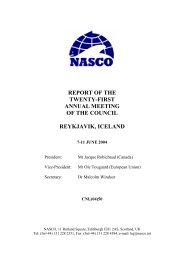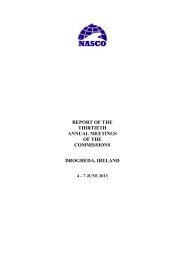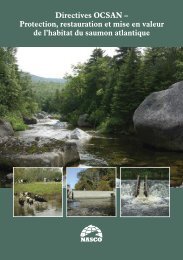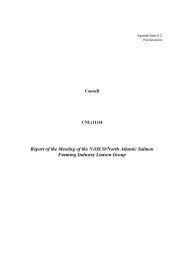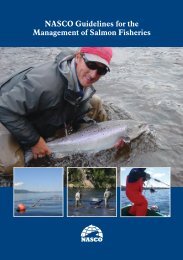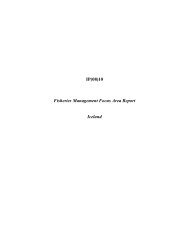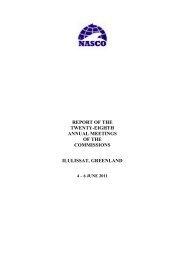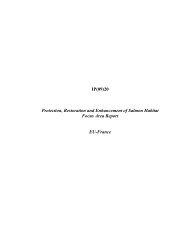Report of the 2005 ICES/NASCO Symposium on Interactions ...
Report of the 2005 ICES/NASCO Symposium on Interactions ...
Report of the 2005 ICES/NASCO Symposium on Interactions ...
Create successful ePaper yourself
Turn your PDF publications into a flip-book with our unique Google optimized e-Paper software.
NINA SPECIAL REPORT 34<br />
principle.<br />
I heard some spokespeople for <str<strong>on</strong>g>the</str<strong>on</strong>g> salm<strong>on</strong> farming sector<br />
accept that <str<strong>on</strong>g>the</str<strong>on</strong>g>se problems exist, that <str<strong>on</strong>g>the</str<strong>on</strong>g> industry is<br />
working hard to fix <str<strong>on</strong>g>the</str<strong>on</strong>g>m, and that we need c<strong>on</strong>sensus<br />
and co-operati<strong>on</strong> to meet <str<strong>on</strong>g>the</str<strong>on</strong>g> challenges, particularly as<br />
t<strong>on</strong>nage <str<strong>on</strong>g>of</str<strong>on</strong>g> farmed salm<strong>on</strong> increases and we see <strong>on</strong>going<br />
development <str<strong>on</strong>g>of</str<strong>on</strong>g> resistance to sea lice medicines.<br />
But I also heard some hints - as <strong>on</strong>e does in o<str<strong>on</strong>g>the</str<strong>on</strong>g>r fora -<br />
that <str<strong>on</strong>g>the</str<strong>on</strong>g>re are still some people within <str<strong>on</strong>g>the</str<strong>on</strong>g> industry who<br />
appear to be in denial about <str<strong>on</strong>g>the</str<strong>on</strong>g> seriousness <str<strong>on</strong>g>of</str<strong>on</strong>g> <str<strong>on</strong>g>the</str<strong>on</strong>g>se<br />
impacts <strong>on</strong> wild fish.<br />
At <str<strong>on</strong>g>the</str<strong>on</strong>g> <str<strong>on</strong>g>NASCO</str<strong>on</strong>g> workshop in Tr<strong>on</strong>dheim this August, Nell<br />
Halse referred to <str<strong>on</strong>g>the</str<strong>on</strong>g> fish farming industry’s ‘justifiable<br />
paranoia’. I believe <str<strong>on</strong>g>the</str<strong>on</strong>g>re are people <strong>on</strong> <str<strong>on</strong>g>the</str<strong>on</strong>g> wild fish and<br />
envir<strong>on</strong>mental side who are also guilty <str<strong>on</strong>g>of</str<strong>on</strong>g> ‘justifiable<br />
paranoia’. We need to get rid <str<strong>on</strong>g>of</str<strong>on</strong>g> <str<strong>on</strong>g>the</str<strong>on</strong>g> culture <str<strong>on</strong>g>of</str<strong>on</strong>g> blame and<br />
look toge<str<strong>on</strong>g>the</str<strong>on</strong>g>r at <str<strong>on</strong>g>the</str<strong>on</strong>g> multiple impacts <strong>on</strong> wild stocks, to<br />
identify what we can tackle.<br />
A str<strong>on</strong>g message I take away from this symposium is that<br />
we’d better address this so<strong>on</strong>er ra<str<strong>on</strong>g>the</str<strong>on</strong>g>r than later because,<br />
as Pat O’Reilly reminded us, many stocks <str<strong>on</strong>g>of</str<strong>on</strong>g> wild salm<strong>on</strong><br />
d<strong>on</strong>’t have <str<strong>on</strong>g>the</str<strong>on</strong>g> luxury <str<strong>on</strong>g>of</str<strong>on</strong>g> time <strong>on</strong> <str<strong>on</strong>g>the</str<strong>on</strong>g>ir side.<br />
We heard that we need to recognise what we can work<br />
to change - and I believe that applies to <str<strong>on</strong>g>the</str<strong>on</strong>g> wild fish<br />
sector too. Where <str<strong>on</strong>g>the</str<strong>on</strong>g>re are multiple effects, it’s<br />
necessary to work co-operatively <strong>on</strong> <str<strong>on</strong>g>the</str<strong>on</strong>g> <strong>on</strong>es we have<br />
<str<strong>on</strong>g>the</str<strong>on</strong>g> power to address.<br />
It’s clear that regulati<strong>on</strong> has a role to play, in both sea lice<br />
management and minimisati<strong>on</strong> <str<strong>on</strong>g>of</str<strong>on</strong>g> escapes. It’s a counsel<br />
<str<strong>on</strong>g>of</str<strong>on</strong>g> perfecti<strong>on</strong> that this should be backed up by local and<br />
regi<strong>on</strong>al co-operati<strong>on</strong>. I sense that <str<strong>on</strong>g>the</str<strong>on</strong>g>re’s a lot <str<strong>on</strong>g>of</str<strong>on</strong>g> interest<br />
in this, and perhaps a message for <str<strong>on</strong>g>NASCO</str<strong>on</strong>g> to take away<br />
is that it could facilitate some ‘cherry-picking’ sessi<strong>on</strong>s to<br />
arrive at some sort <str<strong>on</strong>g>of</str<strong>on</strong>g> guidelines for area management,<br />
based <strong>on</strong> what works and what doesn’t?<br />
I have learned - both in <str<strong>on</strong>g>the</str<strong>on</strong>g> presentati<strong>on</strong>s and in c<str<strong>on</strong>g>of</str<strong>on</strong>g>feebreak<br />
c<strong>on</strong>versati<strong>on</strong>s with o<str<strong>on</strong>g>the</str<strong>on</strong>g>r delegates - that in order<br />
to be effective, area management needs to get better at<br />
engaging communities as well as a wide range <str<strong>on</strong>g>of</str<strong>on</strong>g><br />
stakeholders. It has to be inclusive, transparent, with a<br />
built-in way <str<strong>on</strong>g>of</str<strong>on</strong>g> measuring success - I’d probably add that it<br />
has to be accountable. Both ‘sides’ have to communicate -<br />
particularly in view <str<strong>on</strong>g>of</str<strong>on</strong>g> what we’ve heard about <str<strong>on</strong>g>the</str<strong>on</strong>g><br />
scenario <str<strong>on</strong>g>of</str<strong>on</strong>g> emergent resistance to sea lice medicines, and<br />
<str<strong>on</strong>g>the</str<strong>on</strong>g> importance <str<strong>on</strong>g>of</str<strong>on</strong>g> spotting early signs <str<strong>on</strong>g>of</str<strong>on</strong>g> fish disease.<br />
The challenge is: how do we report successes which may<br />
not be easily measurable, to boost public c<strong>on</strong>fidence and<br />
stakeholder buy-in?<br />
From what I’ve heard here, it seems to me that <str<strong>on</strong>g>the</str<strong>on</strong>g> most<br />
crucial requirement is good - top-notch - communicati<strong>on</strong>.<br />
I believe that we have to go bey<strong>on</strong>d that, because<br />
‘communicati<strong>on</strong>’ can be <strong>on</strong>e-way, particularly government<br />
communicati<strong>on</strong>. We need more c<strong>on</strong>structive dialogue and<br />
cooperati<strong>on</strong>, and trust.<br />
Malcolm menti<strong>on</strong>ed at <str<strong>on</strong>g>the</str<strong>on</strong>g> start that he’s c<strong>on</strong>vinced we<br />
can have ‘win-win’. I’m leaving this ga<str<strong>on</strong>g>the</str<strong>on</strong>g>ring still with a<br />
sense <str<strong>on</strong>g>of</str<strong>on</strong>g> optimism that we can achieve that - but <strong>on</strong>ly if<br />
we can do away with c<strong>on</strong>fr<strong>on</strong>tati<strong>on</strong>, which is seldom<br />
c<strong>on</strong>structive. We need to stop <str<strong>on</strong>g>the</str<strong>on</strong>g> tug-<str<strong>on</strong>g>of</str<strong>on</strong>g>-war and put all<br />
hands to <str<strong>on</strong>g>the</str<strong>on</strong>g> rope to pull in <str<strong>on</strong>g>the</str<strong>on</strong>g> same directi<strong>on</strong> to meet<br />
<str<strong>on</strong>g>the</str<strong>on</strong>g> challenges.<br />
I d<strong>on</strong>’t think we need any more evidence to prove that<br />
<str<strong>on</strong>g>the</str<strong>on</strong>g>re are problems; we need to take that as a given and<br />
move <strong>on</strong> to find cooperative and pragmatic ways <str<strong>on</strong>g>of</str<strong>on</strong>g><br />
addressing <str<strong>on</strong>g>the</str<strong>on</strong>g>se problems. We need to see <str<strong>on</strong>g>the</str<strong>on</strong>g> wild fish<br />
side and <str<strong>on</strong>g>the</str<strong>on</strong>g> industry playing <strong>on</strong> <str<strong>on</strong>g>the</str<strong>on</strong>g> same team and<br />
seeking out <str<strong>on</strong>g>the</str<strong>on</strong>g> comm<strong>on</strong> ground.<br />
The worst outcome would be ano<str<strong>on</strong>g>the</str<strong>on</strong>g>r <str<strong>on</strong>g>NASCO</str<strong>on</strong>g> meeting<br />
in several years’ time where we still hear mounting<br />
evidence <str<strong>on</strong>g>of</str<strong>on</strong>g> problems. The next <strong>on</strong>e needs to be a<br />
record <str<strong>on</strong>g>of</str<strong>on</strong>g> <str<strong>on</strong>g>the</str<strong>on</strong>g> soluti<strong>on</strong>s that are being explored!<br />
3. Knut A. Hjelt<br />
During <str<strong>on</strong>g>the</str<strong>on</strong>g> last three days we have had a number <str<strong>on</strong>g>of</str<strong>on</strong>g><br />
presentati<strong>on</strong>s focusing mainly <strong>on</strong> <str<strong>on</strong>g>the</str<strong>on</strong>g> possible interacti<strong>on</strong><br />
between aquaculture and wild stocks <str<strong>on</strong>g>of</str<strong>on</strong>g> Atlantic salm<strong>on</strong>.<br />
The symposium has shown us that today we have much<br />
more science-based informati<strong>on</strong> about possible<br />
interacti<strong>on</strong>s between aquaculture and wild fish than<br />
before.<br />
The industry is still young, but over <str<strong>on</strong>g>the</str<strong>on</strong>g> years it has<br />
evolved tremendously, and will c<strong>on</strong>tinue to evolve in <str<strong>on</strong>g>the</str<strong>on</strong>g><br />
future. As we have heard, <str<strong>on</strong>g>the</str<strong>on</strong>g> industry has put a lot <str<strong>on</strong>g>of</str<strong>on</strong>g><br />
effort into preventing possible negative interacti<strong>on</strong>s with<br />
<str<strong>on</strong>g>the</str<strong>on</strong>g> wild stocks. The focus has been <strong>on</strong> health, technical<br />
improvements, codes <str<strong>on</strong>g>of</str<strong>on</strong>g> best practice, site selecti<strong>on</strong> and<br />
good training and management. The producti<strong>on</strong> <str<strong>on</strong>g>of</str<strong>on</strong>g><br />
Atlantic salm<strong>on</strong> is mainly based in areas where <str<strong>on</strong>g>the</str<strong>on</strong>g> wild<br />
Atlantic salm<strong>on</strong> is most abundant, which in itself is a<br />
challenge. But populati<strong>on</strong>s <str<strong>on</strong>g>of</str<strong>on</strong>g> Atlantic salm<strong>on</strong> are facing a<br />
variety <str<strong>on</strong>g>of</str<strong>on</strong>g> possible threats, and attenti<strong>on</strong> must be paid to<br />
all kinds <str<strong>on</strong>g>of</str<strong>on</strong>g> negative interacti<strong>on</strong>s, not <strong>on</strong>ly <str<strong>on</strong>g>the</str<strong>on</strong>g> topics<br />
c<strong>on</strong>sidered during this symposium.<br />
65



